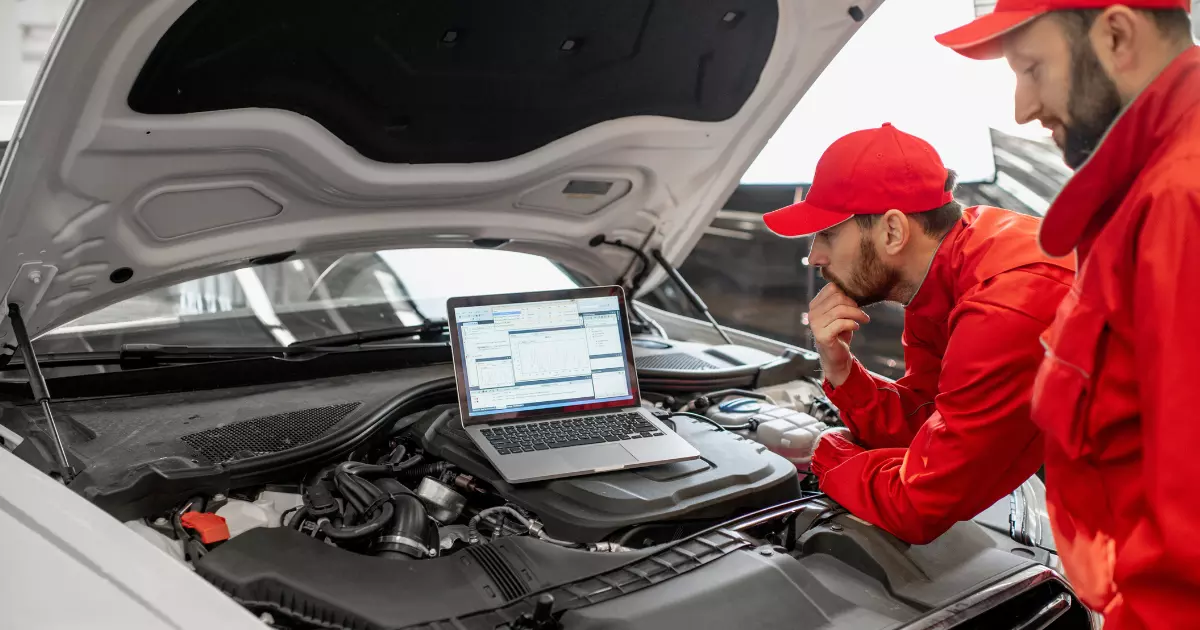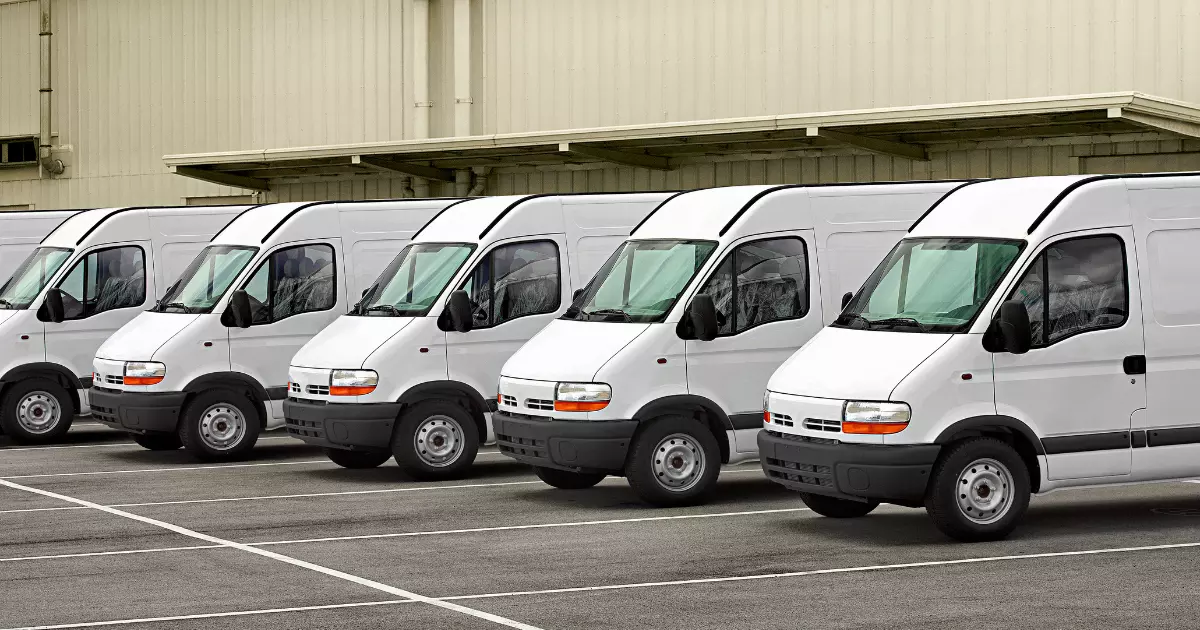Ensuring the smooth operation of commercial vehicles is essential for fleet managers. Implementing effective preventive and routine maintenance strategies can minimize downtime and maximize efficiency. In this article, we’ll guide you on understanding commercial fleet maintenance. We will also share top-tier solutions to help commercial customers optimize their operations. Then, we’ll delve into practical tips and strategies you should know about.
Ready to discover how these solutions can benefit your business and ensure your fleet remains reliable and cost-effective? Keep reading to learn more about efficient commercial fleet maintenance solutions and take your fleet management to the next level.
What is Commercial Fleet Maintenance?
Commercial fleet maintenance involves the regular upkeep and repair of a company’s fleet of vehicles, including trucks, vans, cars, or specialized vehicles, used for business purposes. The primary goal is to ensure that the entire fleet remains in optimal condition, minimizing downtime and reducing the risk of unexpected breakdowns.
Fleet managers implement preventive maintenance schedules and utilize fleet management software to streamline maintenance tasks, track vehicle performance, and manage maintenance schedules efficiently. By proactively addressing maintenance needs, businesses can control fuel costs, optimize operational efficiency, and enhance customer service.
Additionally, effective commercial fleet maintenance plays a crucial role in supporting business management efforts, ensuring that vehicles are safe to operate and meet regulatory requirements. For trucking companies and other businesses reliant on a fleet of vehicles, prioritizing commercial fleet maintenance is essential for sustaining productivity, minimizing repair costs, and meeting customer service expectations.
Why is Commercial Fleet Maintenance Important?

Effective commercial fleet maintenance is paramount for fleet managers to uphold the reliability and efficiency of their fleet vehicles. Regular maintenance reduces the likelihood of unexpected breakdowns, keeping vehicles on the road and minimizing disruptions to operations. Also, adhering to a structured maintenance schedule helps identify and address potential issues before they escalate. Thus, it lowers repair costs over time.
Additionally, a well-maintained fleet contributes to enhanced safety for drivers and the public. This decreases the risk of accidents and associated liabilities. A comprehensive fleet maintenance program helps you follow regulations. This avoids fines and penalties as well. Moreover, prioritizing commercial fleet maintenance is crucial. It optimizes operational performance and controls maintenance expenses in the long run. Here are some of the reasons why commercial fleet maintenance is important.
1. Minimize Downtime
Minimizing downtime is a crucial reason why commercial fleet maintenance is essential. Fleet vehicles are the backbone of many businesses. Any unexpected breakdown or maintenance issue can significantly disrupt operations, leading to lost productivity and revenue. Effective maintenance practices, such as routine inspections and preventive maintenance schedules, help identify and address potential issues before they escalate into major problems.
Thus, minimizing the risk of unexpected downtime. By keeping the fleet vehicles operational and reliable, businesses can ensure smooth and uninterrupted operations. Meeting customer demands and maintaining a competitive edge in the market. Therefore, prioritizing commercial fleet maintenance becomes paramount for businesses seeking to minimize downtime and maximize operational efficiency.
2. Cost Savings
Opting for preventive maintenance measures in commercial fleet management can lead to significant cost savings over time. This is by minimizing repair costs and reducing maintenance expenses. Fleet managers invest in routine maintenance activities. These include oil changes, tire rotations, and fluid checks. Businesses follow a structured preventive maintenance schedule. It helps predict and manage maintenance costs effectively. This allows for better budget planning and resource allocation. Moreover, reducing the frequency of unscheduled maintenance events helps avoid costly business downtime. It also maximizes fleet availability and operational efficiency. Prioritizing cost-effective maintenance practices helps businesses optimize their fleet maintenance budgets. It ensures the long-term reliability and performance of their service vehicles.
3. Safety Assurance
Commercial fleet maintenance plays a crucial role in ensuring the safety of fleet vehicles, drivers, and the public. Fleet managers focus on regular maintenance activities. These include brake inspections, tire checks, and vehicle servicing. They identify and address potential safety issues before they escalate. This proactive approach helps minimize the risk of accidents. It also reduces injuries, and liabilities for the company and protects its workforce. Moreover, maintaining compliance with safety regulations and standards ensures that fleet vehicles meet required safety specifications. This is by reducing the likelihood of fines or penalties for non-compliance. Businesses emphasize safety through proper maintenance practices. They show commitment to protecting employees, commercial customers, and communities. This enhances their reputation and trustworthiness in the industry.
4. Extend Vehicle Lifespan
Regular maintenance is essential for extending the lifespan of fleet vehicles. This maximizes their value and reduces the frequency of replacements. Commercial fleet managers focus on preventive maintenance activities. These include engine tune-ups, fluid checks, and component replacements. They cut wear and tear on vehicle components to maintain optimal conditions for longer periods. This proactive approach not only reduces repair costs and maintenance expenses but also maximizes the return on investment for fleet vehicles. By extending the lifespan of their vehicles, businesses delay the need for new purchases. This saves money on acquisition costs and depreciation. Additionally, well-maintained vehicles tend to retain their resale value better. It further enhances the company’s financial position. Prioritizing vehicle longevity is essential in the fleet industry and it can be done through regular maintenance practices. This optimizes fleet management and minimizes operating costs in the long run.
How to Create An Efficient Commercial Fleet Maintenance Strategy?

Efficient commercial fleet maintenance is crucial for businesses. It helps optimize operations and cut costs associated with unplanned downtime. By establishing a comprehensive maintenance strategy, companies ensure the reliability and longevity of their fleet of vehicles. This leads to increased customer satisfaction and improved cost management. To achieve this, it’s essential to identify and focus on key components that contribute to an effective maintenance program. Now, let’s explore how you can create an efficient commercial fleet maintenance strategy.
1. Schedule Preventative Fleet Maintenance
Establishing a regular maintenance schedule addresses potential issues before they escalate, minimizing the risk of unplanned downtime and costly fleet repair services. That’s why it is important to implement preventative maintenance schedules. This ensures that fleet vehicles undergo routine inspections, servicing, and repairs on time. However, bear in mind that these should based on manufacturer recommendations and industry best practices.
2. Utilize Fleet Management Software
The utilization of fleet management software is a critical component of an efficient commercial fleet maintenance strategy. By leveraging advanced software solutions, businesses can streamline maintenance tasks, track vehicle performance, and optimize maintenance schedules more effectively. Integrating technology into fleet maintenance processes enables businesses to access real-time insights into vehicle health. It also automates maintenance reminders and manages fleet operations from a centralized platform. This proactive approach to maintenance management enhances operational efficiency, reduces downtime, and ultimately contributes to cost savings for businesses.
3. Focus on Cost Management
Cost management is another fundamental aspect of an efficient commercial fleet maintenance strategy. To manage costs, as mentioned above, implement preventive maintenance schedules to avoid costly repairs. You can also optimize fuel consumption to reduce operational costs. Plus, you can leverage technology to streamline maintenance workflows and identify cost-saving opportunities. Remember that proactive cost management practices allow businesses to forecast maintenance expenses more accurately. As a result, you can have a better budget planning and financial management. Focusing on cost management ensures that businesses can maintain their fleet vehicles’ reliability and performance while maximizing cost efficiency.
5. Enhance Customer Satisfaction
Enhancing customer satisfaction is a vital aspect of an efficient commercial fleet maintenance strategy. By maintaining reliable vehicles through preventive maintenance schedules, businesses meet customer service demands effectively. A well-maintained fleet reflects professionalism. Hence, it creates customer trust and loyalty. Ultimately, prioritizing customer satisfaction helps businesses gain a competitive edge and build long-term relationships with their clientele.
How Can Technology Streamline Commercial Fleet Maintenance?
Technology plays a pivotal role in streamlining operations and enhancing efficiency. Leveraging advanced fleet maintenance management programs and vehicle maintenance software enables businesses to automate and optimize maintenance processes. These tools provide commercial fleet managers with real-time insights into vehicle health. They can identify potential issues before they escalate.
Additionally, they can manage and monitor preventative maintenance schedules. This ensures that fleet vehicles undergo routine services according to manufacturer recommendations and industry standards.
Moreover, technology facilitates the integration of scheduled maintenance reminders and alerts. Remember that timely interventions prevent emergency maintenance situations. Whether it’s monitoring vehicle diagnostics or tracking maintenance history, technology empowers businesses. It helps them streamline maintenance workflows and maximize fleet uptime. By embracing technological advancements in fleet services, companies can achieve greater efficiency. They can also reduce costs and optimize the performance of their commercial fleet operations.
What Innovative Technologies are Available to Streamline Commercial Fleet Maintenance?

In the field of commercial fleet maintenance, innovative technologies have emerged as game-changers. They revolutionized the way businesses manage their fleets. These advancements streamline maintenance processes as well. They also optimize fleet performance and minimize costs associated with unplanned downtime. From sophisticated fleet management software to cutting-edge diagnostic tools, various technologies are available nowadays. They enhance efficiency and effectiveness in fleet maintenance. Let’s explore five key components of these innovative technologies and how they contribute to efficient commercial fleet maintenance solutions.
1. Telematics and GPS Tracking Systems
Telematics and GPS tracking systems revolutionize commercial fleet maintenance by providing real-time insights into vehicle location, performance, and health. These advanced technologies enable fleet managers to track the status of their vehicles. They allow for proactive maintenance interventions before issues escalate. Some of those issues are engine malfunctions and excessive wear on components. By identifying potential problems early on, fleet managers can schedule timely repairs. This minimizes the risk of unexpected breakdowns and costly repairs.
2. Predictive Maintenance Solutions
Predictive maintenance solutions offer significant benefits to commercial fleet management by leveraging advanced data analytics and machine learning algorithms to anticipate potential issues before they occur. By analyzing historical maintenance data and monitoring key performance indicators in real time, predictive maintenance solutions can accurately predict when maintenance tasks are needed. This allows fleet managers to proactively address issues before they result in costly breakdowns or disruptions to operations.
3. Remote Diagnostics and IoT Sensors
Remote diagnostics and IoT sensors are game-changers in commercial fleet maintenance. They offer real-time monitoring and analysis of vehicle performance and health. By leveraging IoT sensors installed in fleet vehicles, fleet managers can collect real-time data on various parameters. These include engine health, fuel consumption, tire pressure, and more. Data are then transmitted to centralized systems where sophisticated algorithms analyze it to detect potential issues or anomalies. With remote diagnostics, fleet managers can identify maintenance needs. They can schedule repairs and optimize fleet performance. This proactive approach not only minimizes downtime but also improves fleet efficiency and extends the lifespan of vehicles.
4. Mobile Workforce Management Apps
Mobile Workforce Management Apps enable seamless communication and coordination between fleet managers, drivers, and maintenance teams. They help efficient scheduling of maintenance tasks and repairs. With mobile apps, technicians can receive work orders and access vehicle history and manuals from their mobile devices. They can also update maintenance records which eliminates manual paperwork. This streamlines administrative processes. Furthermore, these apps often integrate with GPS and telematics systems. It allows fleet managers to track the location of vehicles and their real-time status.
5. Cloud-Based Fleet Management Platforms
Cloud-based fleet management platforms revolutionize commercial fleet maintenance by providing a centralized hub for managing all aspects of fleet operations. These platforms offer real-time visibility into vehicle health, performance, and location data. They empower fleet managers to make informed decisions and address maintenance needs. By leveraging cloud-based technology, fleet managers can access critical information from any location with internet access. This enables seamless communication and collaboration between teams.
What Are The Common Fleet Maintenance Challenges?

Fleet maintenance is crucial for businesses reliant on a fleet of vehicles to ensure optimal performance and minimize disruptions. However, several challenges can hinder efficient maintenance practices. Each of these challenges presents unique obstacles that fleet managers must navigate to maintain the reliability and efficiency of their fleet operations.
Keeping Up with Preventive Maintenance
Keeping up with preventive maintenance schedules can be challenging due to the sheer size of the fleet and the need to coordinate maintenance activities across multiple vehicles. Failure to adhere to preventive maintenance schedules can lead to increased risk of breakdowns and costly repairs, impacting fleet reliability and operational efficiency.
Unexpected Repairs and Downtime
Unexpected repairs and downtime can disrupt fleet operations and lead to increased costs and decreased productivity. These unplanned events often occur due to equipment failures or accidents, requiring immediate attention and resources to get vehicles back on the road swiftly.
Unexpected Expenses
Unexpected expenses, such as unforeseen repairs or increases in fuel prices, can strain the budget allocated for fleet maintenance. These expenses may arise suddenly, making it challenging for businesses to manage their finances effectively and maintain profitability.
Unavailability of Parts
The unavailability of parts can delay repair processes and prolong vehicle downtime. This challenge may arise due to supply chain disruptions, discontinued parts, or difficulties sourcing specific components required for repairs, hampering fleet maintenance efforts.
Rapid Pace of Technological Change
The rapid pace of technological change introduces new complexities to fleet maintenance, requiring fleet managers to stay updated on the latest advancements in vehicle technology. Adapting to new technologies, such as electric vehicles or advanced diagnostic systems, may necessitate additional training and resources.
Shortage of Skilled Technicians
A shortage of skilled technicians poses a significant challenge for fleet maintenance operations. The demand for qualified technicians often exceeds the available workforce, making it challenging for businesses to recruit and retain skilled professionals. This shortage can lead to delays in repairs and increased reliance on outsourcing, impacting overall fleet maintenance efficiency.
How Can I Maintain My Commercial Fleet?

When it comes to managing a commercial fleet, proper maintenance is key to ensuring smooth operations and minimizing operational costs. Implementing a few key practices can help business owners and fleet managers keep their business vehicles in optimal condition. This reduces the risk of breakdowns and maximizes efficiency. By following these tips, truck companies and businesses with various types of vehicles can keep their fleet running. This improves driver safety and reduces repair time which leads to a more efficient and cost-effective operation. Now, let’s explore five practical tips for commercial fleet maintenance that can help businesses keep their drivers safe and their fleets in top condition.
1. Routine Vehicle Inspections
Maintaining your commercial fleet through vehicle inspections involves conducting regular checks on each vehicle. These inspections should cover essential areas such as brakes, tires, fluids, lights, and overall vehicle condition. By performing these inspections, you can identify any issues early and address them promptly to ensure the safety and reliability of your fleet. Regular inspections also help prevent unexpected breakdowns and costly repairs, ultimately minimizing downtime and maximizing fleet efficiency.
2. Driver Training and Monitoring
Maintaining your commercial fleet through driver training and monitoring involves providing comprehensive training to your drivers on safe driving practices and proper vehicle maintenance. This includes educating them on factors such as defensive driving, fuel-efficient driving techniques, and regular vehicle checks. Additionally, implementing a system to monitor driver behavior, such as speeding, harsh braking, and idling, allows you to identify areas for improvement and address any issues promptly.
3. Adherence to Preventative Maintenance Schedules
Adhering to preventive maintenance schedules involves scheduling regular maintenance tasks based on vehicle manufacturer recommendations and industry best practices. This includes routine inspections, fluid checks, oil changes, and component replacements. By following these schedules, businesses can identify and address potential issues before they escalate into major problems, minimizing the risk of unexpected breakdowns and costly repairs.
4. Use of Technology
Maintaining a commercial fleet through the use of technology involves leveraging advanced solutions such as fleet management software, telematics systems, and IoT sensors. These technologies provide real-time insights into vehicle health, performance, and location data. Fleet managers can use this information to monitor maintenance needs, automate reminders for scheduled maintenance tasks, and optimize maintenance schedules. Additionally, technology enables remote diagnostics, allowing fleet managers to proactively identify issues and schedule repairs before they lead to costly breakdowns. Integration of technology streamlines maintenance workflows enhances operational efficiency, and contributes to cost savings.
5. Establishing a Fleet Strategy
Maintaining a commercial fleet through the establishment of a fleet strategy involves outlining clear maintenance goals, schedules, and budgets. A comprehensive fleet strategy helps businesses manage their fleet more effectively by providing a roadmap for maintenance activities. It includes defining maintenance intervals, setting up preventive maintenance schedules, and allocating resources accordingly. Additionally, a well-defined strategy enables businesses to adapt to changing needs and optimize their fleet maintenance processes over time.
Wrapping Up
Efficient commercial fleet maintenance optimizes operations, reduces costs, and ensures safety. Implementing a comprehensive maintenance management process streamlines workflows and maximizes fleet uptime. Regular vehicle inspections, preventive maintenance, and driver training are essential. Technology like fleet management software provides valuable insights into performance.
Effective communication with drivers and service providers is crucial. Prioritizing maintenance practices optimizes fuel consumption and extends equipment lifespan. Establishing a close relationship with a dedicated mechanic reduces repair time. Careful fuel management and tailored maintenance plans contribute to cost reduction. Proactive maintenance and communication maximize efficiency and longevity.
Ready to optimize your commercial fleet maintenance and maximize efficiency? Look no further than JP Auto and Fleet Services. With our comprehensive fleet maintenance management process and cutting-edge technology solutions, we offer the ultimate solution to your fleet maintenance challenges. Contact us today to learn more and take your fleet management to the next level! Our services are available to customers in Lewisville, Texas, DFW, TX, and throughout the Dallas-Fort Worth area.


